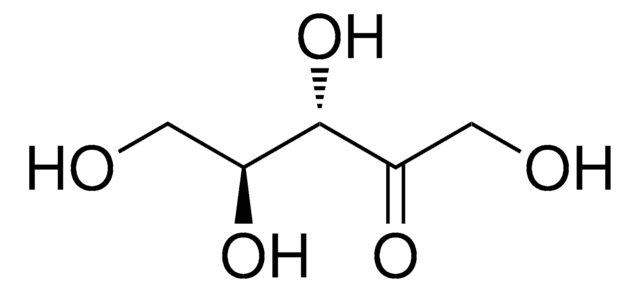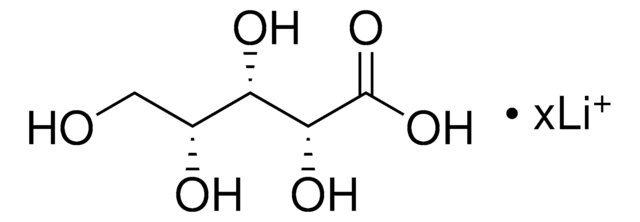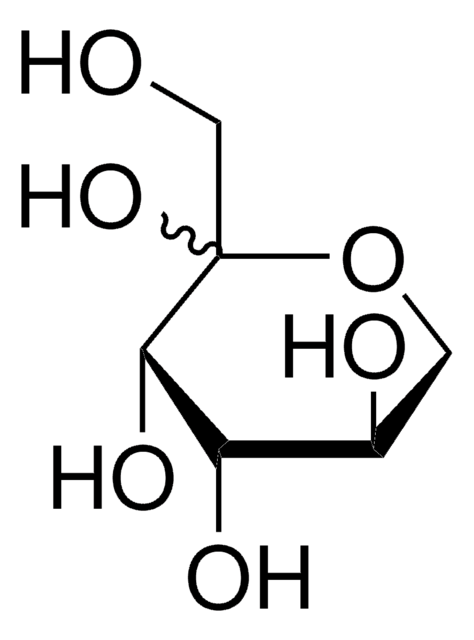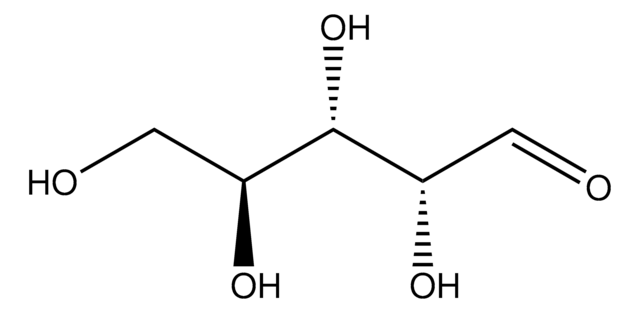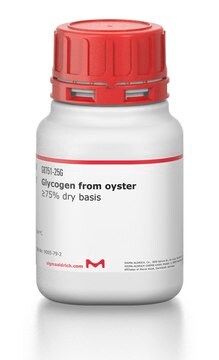Wszystkie zdjęcia(1)
Kluczowe dokumenty
76512
D-Ribulose solution
~1 M in H2O, ≥97.0% (HPLC)
Synonim(y):
D-erythro-2-Ketopentose solution, D-erythro-2-Pentulose solution, D-Adonose solution, D-Arabinulose solution, D-Araboketose solution, D-Erythropentulose solution
Zaloguj sięWyświetlanie cen organizacyjnych i kontraktowych
About This Item
Wzór empiryczny (zapis Hilla):
C5H10O5
Numer CAS:
Masa cząsteczkowa:
150.13
Numer MDL:
Kod UNSPSC:
12352204
Identyfikator substancji w PubChem:
NACRES:
NA.32
Polecane produkty
Poziom jakości
Próba
≥97.0% (HPLC)
Formularz
liquid
stężenie
~1 M in H2O
kolor
colorless
temp. przechowywania
2-8°C
ciąg SMILES
OCC1(O)OC[C@@H](O)[C@H]1O
InChI
1S/C5H10O5/c6-2-5(9)4(8)3(7)1-10-5/h3-4,6-9H,1-2H2/t3-,4-,5?/m1/s1
Klucz InChI
LQXVFWRQNMEDEE-ZZKAVYKESA-N
Działania biochem./fizjol.
D-rybuloza jest metabolitem w interkonwersjach pentozy i glukuronianu. Odgrywa rolę w produkcji D-arabitolu z U. fabae. Rybuloza jest rzadką aldopentozą, która może wykazywać działanie przeciwnowotworowe i przeciwwirusowe. Działa jako substrat dla zależnej od fosforanu dinukleotydu nikotynamidoadeninowego (NADP+) dehydrogenazy D-arabitolu(ARD1p) enzymu i D-tagatozo-3-epimerazy z Rhodobacter sphaeroides. Jego monofosforan D-rybulozo-5-fosforan jest produktem pośrednim w szlaku fosforanu pentozy glikolizy. D-rybulozę można znaleźć w roślinach takich jak algi, liście buraka cukrowego i liście nasion jęczmienia.
Opakowanie
Bottomless glass bottle. Contents are inside inserted fused cone.
Inne uwagi
Aby uzyskać kompleksowe zrozumienie naszej szerokiej gamy Monosacharydy do swoich badań, zachęcamy do odwiedzenia naszej strony stronę kategorii Węglowodany.
Ta strona może zawierać tekst przetłumaczony maszynowo.
Kod klasy składowania
10 - Combustible liquids
Klasa zagrożenia wodnego (WGK)
WGK 3
Temperatura zapłonu (°F)
Not applicable
Temperatura zapłonu (°C)
Not applicable
Wybierz jedną z najnowszych wersji:
Masz już ten produkt?
Dokumenty związane z niedawno zakupionymi produktami zostały zamieszczone w Bibliotece dokumentów.
Klienci oglądali również te produkty
Tobias Link et al.
The Biochemical journal, 389(Pt 2), 289-295 (2005-03-31)
We have identified and characterized a novel NADP(+)-dependent D-arabitol dehydrogenase and the corresponding gene from the rust fungus Uromyces fabae, a biotrophic plant pathogen on broad bean (Vicia faba). The new enzyme was termed ARD1p (D-arabitol dehydrogenase 1). It recognizes
Kosei Takeda et al.
Acta crystallographica. Section F, Structural biology and crystallization communications, 64(Pt 10), 945-948 (2008-10-22)
D-Arabinose isomerase catalyzes the isomerization of D-arabinose to D-ribulose. Bacillus pallidus D-arabinose isomerase has broad substrate specificity and can catalyze the isomerization of D-arabinose, L-fucose, L-xylose, L-galactose and D-altrose. Recombinant B. pallidus D-arabinose isomerase was overexpressed, purified and crystallized. A
Ye-Wang Zhang et al.
Applied microbiology and biotechnology, 87(6), 1993-1999 (2010-05-25)
Recombinant Escherichia coli harboring the L: -arabinose isomerase (BLAI) from Bacillus licheniformis was used as a biocatalyst to produce L: -ribulose in the presence of borate. Effects of substrate concentration, the borate to L: -arabinose ratio, pH, and temperature on
Ye-Wang Zhang et al.
Preparative biochemistry & biotechnology, 40(1), 65-75 (2009-12-22)
Recombinant Escherichia coli whole cells harboring Bacillus licheniformis L-arabinose isomerase (BLAI) were harvested to prepare alginate-immobilized biocatalysts. The operational conditions for immobilization were optimized according to relative activity and the cell leakage of the immobilized cell. The optimal conditions are
Chakkiath Paul Antony et al.
International journal of systematic and evolutionary microbiology, 62(Pt 7), 1613-1618 (2011-09-06)
A moderately haloalkaliphilic methylotrophic bacterium possessing the ribulose monophosphate pathway for carbon assimilation, designated MPL(T), was isolated from Lonar Lake sediment microcosms that were oxidizing methane for two weeks. The isolate utilized methanol and was an aerobic, Gram-negative, asporogenous, motile
Nasz zespół naukowców ma doświadczenie we wszystkich obszarach badań, w tym w naukach przyrodniczych, materiałoznawstwie, syntezie chemicznej, chromatografii, analityce i wielu innych dziedzinach.
Skontaktuj się z zespołem ds. pomocy technicznej